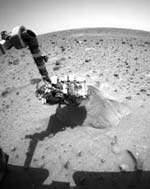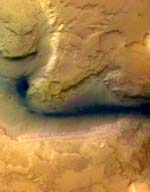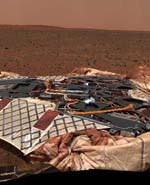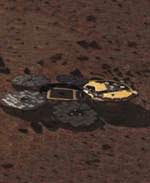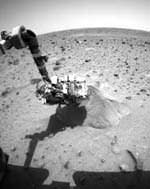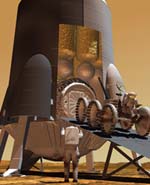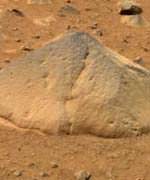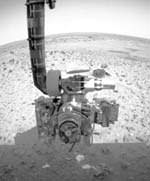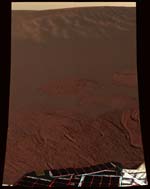
Image credit: NASA/JPL
NASA’s Opportunity rover successfully landed on the surface of Mars early Sunday morning, giving the agency two successful landings this month. The spacecraft landed in a region of Mars called Meridiani Planum which is on the opposite side of the planet from Gusev Crater. Initial estimates placed the rover about 24 km down range from the centre of the target area, but well within the regions of hematite which could be an indication of past water. Unlike Spirit, Opportunity landed on its side and righted itself when it opened the petals of its lander. Opportunity’s airbags aren’t blocking the exit ramp, so there won’t be a problem when the rover rolls out onto the Martian surface.
NASA’s second Mars Exploration Rover successfully sent signals to Earth during its bouncy landing and after it came to rest on one of the three side petals of its four-sided lander.
Mission engineers at NASA’s Jet Propulsion Laboratory, Pasadena, Calif., received the first signal from Opportunity on the ground at 9:05 p.m. Pacific Standard Time Saturday via the NASA Deep Space Network, which was listening with antennas in California and Australia.
“We’re on Mars, everybody!” JPL’s Rob Manning, manager for development of the landing system, announced to the cheering flight team.
NASA Administrator Sean O’Keefe said at a subsequent press briefing, “This was a tremendous testament to how NASA, when really focused on an objective, can put every ounce of effort, energy, emotion and talent to an important task. This team is the best in the world, no doubt about it.”
Opportunity landed in a region called Meridiani Planum, halfway around the planet from the Gusev Crater site where its twin rover, Spirit, landed three weeks ago. Earlier today, mission managers reported progress in understanding and dealing with communications and computer problems on Spirit.
“In the last 48 hours, we’ve been on a roller coaster,” said Dr. Ed Weiler, NASA associate administrator for space science. “We resurrected one rover and saw the birth of another.”
JPL’s Pete Theisinger, project manager for the rovers, said, “We are two for two. Here we are tonight with Spirit on a path to recovery and with Opportunity on Mars.”
By initial estimates, Opportunity landed about 24 kilometers (15 miles) down range from the center of the target landing area. That is well within an outcropping of a mineral called gray hematite, which usually forms in the presence of water. “We’re going to have a good place to do science,” said JPL’s Richard Cook, deputy project manager for the rovers.
Once it pushed itself upright by opening the petals of the lander, Opportunity was expected to be facing east.
The main task for both rovers in coming months is to explore the areas around their landing sites for evidence in rocks and soils about whether those areas ever had environments that were watery and possibly suitable for sustaining life.
JPL, a division of the California Institute of Technology in Pasadena, manages the Mars Exploration Rover project for NASA’s Office of Space Science, Washington. Images and additional information about the project are available from JPL at http://marsrovers.jpl.nasa.gov and from Cornell University, Ithaca, N.Y., at http://athena.cornell.edu .
Original Source: NASA/JPL News Release

